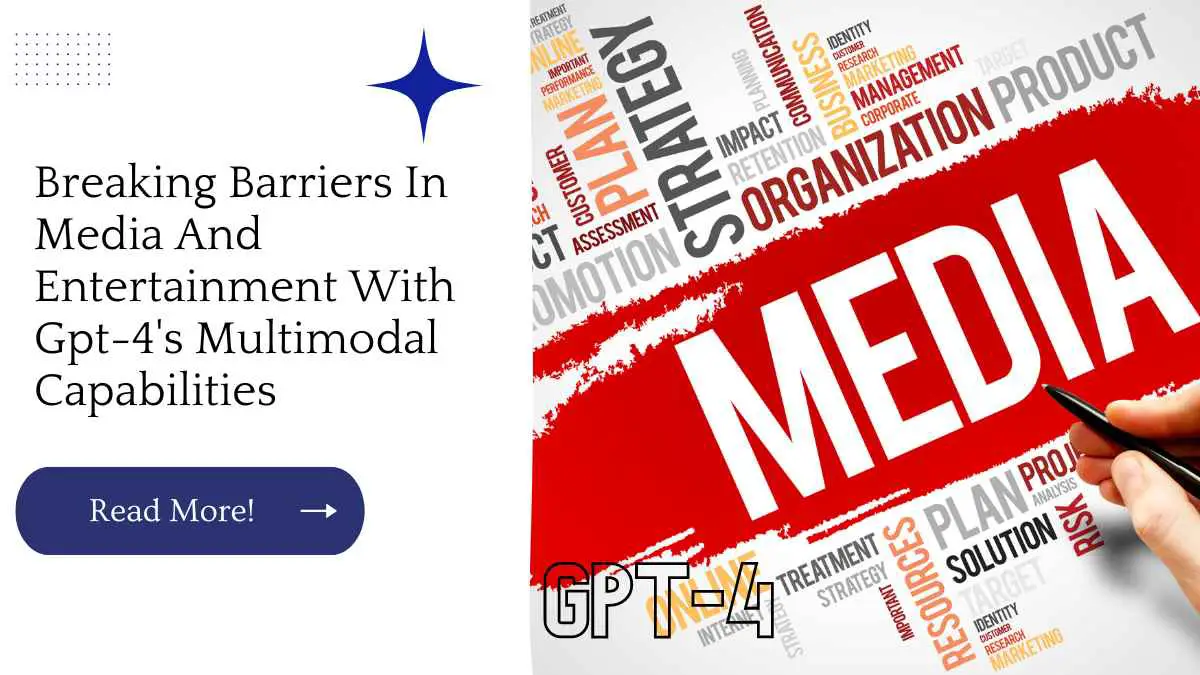The media and entertainment industry has witnessed significant growth and transformation in recent years. The industry is continuously evolving, and advancements in technology have played a vital role in this growth.
One of the latest technologies in this industry is GPT-4, a multimodal model from Microsoft-OpenAI. GPT-4 has the potential to revolutionize the way media and entertainment companies work. In this blog post, we will discuss how GPT-4 can break barriers in media and entertainment with its multimodal capabilities.
| Takeaways |
|---|
| GPT-4 is the next generation of language AI developed by OpenAI. |
| Multimodal AI uses multiple modes of input, such as text, images, and speech, to understand and respond to user queries. |
| Multimodal AI has the potential to enhance user experience, improve decision-making, and drive innovation in various industries. |
| GPT-4’s multimodal capabilities can enable it to process and analyze large amounts of data from multiple sources, providing more comprehensive insights for decision-making. |
| GPT-4 is expected to be released in March 2023 and could revolutionize language AI. |
Improved Content Creation with Multimodal Capabilities
GPT-4’s multimodal capabilities make it possible to create content that is more engaging, interactive, and personalized.
By integrating text, images, video, and sound, GPT-4 can produce content that appeals to a broader audience. For instance, GPT-4 can be used to create virtual reality experiences that transport users to different locations, providing a more immersive experience.
Enhanced Language Capabilities for Multilingual Audiences
GPT-4’s ability to work across multiple languages makes it easier for media and entertainment companies to reach a more diverse audience.
For instance, a movie production company can use GPT-4 to translate movie scripts into different languages, making it possible to release the movie in multiple countries without having to create different versions of the movie. Additionally, GPT-4 can also be used to create subtitles in real-time, making it easier for viewers to watch movies and TV shows in different languages.
GPT-4 is truly a game-changer in the world of AI language generation, and its unmatched performance can unlock a range of possibilities. Read our deep dive into the power of GPT-4 to learn more about its revolutionary capabilities.
Improved User Experience with Personalization
GPT-4’s multimodal capabilities can be used to personalize the user experience. For instance, GPT-4 can be used to create a virtual assistant that can recommend content to users based on their viewing habits, preferences, and interests. By doing this, media and entertainment companies can improve the user experience and increase engagement with their content.
Advanced Video Editing and Post-Production Capabilities
GPT-4’s ability to integrate text, images, video, and sound can also be used to enhance video editing and post-production capabilities.
For instance, GPT-4 can be used to automatically generate captions, transcribe audio, and add visual effects to videos. This can significantly reduce the time and effort required to produce high-quality videos.
The next leap in AI language generation has finally arrived, and it’s called GPT-4. With its advanced features and capabilities, GPT-4 can transform the way we think about language. Check out our article on GPT-4’s next leap to stay up-to-date on the latest developments in AI language technology.
Improved Content Discovery and Recommendation
GPT-4’s multimodal capabilities can be used to improve content discovery and recommendation. For instance, media and entertainment companies can use GPT-4 to analyze user data to recommend content that is most likely to be of interest to them. This can significantly improve engagement with their content and increase user satisfaction.
Improved Accessibility for Users with Disabilities
GPT-4’s multimodal capabilities can also be used to improve accessibility for users with disabilities.
For instance, GPT-4 can be used to automatically generate closed captions, making it easier for viewers who are deaf or hard of hearing to watch movies and TV shows. Additionally, GPT-4 can also be used to generate audio descriptions of videos, making it easier for viewers who are visually impaired to enjoy content.
Social media is constantly evolving, and with the help of GPT-4, user experience can be greatly enhanced. Learn more about how GPT-4 can improve social media in our article on enhancing user experience with multimodal AI.
Advanced Advertising Capabilities
GPT-4’s multimodal capabilities can also be used to improve advertising capabilities. For instance, GPT-4 can be used to generate personalized ads that are more likely to be of interest to viewers. Additionally, GPT-4 can also be used to analyze viewer data to determine the best time and place to display ads, improving the effectiveness of advertising campaigns.
Improved Content Security and Copyright Protection
GPT-4’s multimodal capabilities can also be used to improve content security and copyright protection.
For instance, GPT-4 can be used to detect and remove copyrighted material from videos and images, ensuring that media and entertainment companies do not violate copyright laws. Additionally, GPT-4 can also be used to detect and prevent unauthorized access to content, reducing the risk of piracy.
The education sector can greatly benefit from GPT-4’s multimodal capabilities. With its ability to enhance learning through multilingual and multimodal models, GPT-4 can revolutionize the way students learn. Check out our article on GPT-4 in education to learn more about its potential impact.
Enhanced Live Broadcasting Capabilities
GPT-4’s multimodal capabilities can also be used to enhance live broadcasting capabilities. For instance, GPT-4 can be used to automatically generate real-time translations of live broadcasts, making it possible for viewers to watch broadcasts in different languages. Additionally, GPT-4 can also be used to generate live captions, making it easier for viewers who are deaf or hard of hearing to follow along.
Improved Data Analysis and Insights
GPT-4’s multimodal capabilities can be used to improve data analysis and insights. For instance, media and entertainment companies can use GPT-4 to analyze viewer data to identify trends and preferences.
This can help companies create content that is more likely to appeal to their target audience, improving engagement and satisfaction.
GPT-4 has the potential to enhance data analysis and decision-making in environmental sustainability, making it a crucial tool for organizations and individuals seeking to make a positive impact on the planet. Learn more about GPT-4’s potential in our article on enhancing data analysis and decision-making with multimodal AI.
Conclusion
In conclusion, GPT-4 has the potential to revolutionize the media and entertainment industry with its multimodal capabilities. By integrating text, images, video, and sound, GPT-4 can improve content creation, enhance language capabilities, personalize user experiences, improve advertising capabilities, enhance live broadcasting, improve data analysis, and much more.
Media and entertainment companies that adopt GPT-4 will be able to break barriers and stay ahead of the competition, providing better experiences to their audiences.
Further Reading
Here are some additional resources to learn more about multimodal AI and GPT-4:
What is Multimodal AI? GPT-4?: This article provides an overview of multimodal AI and GPT-4, including their potential impact on various industries.
Multimodal AI: The Future of AI: This blog post explores the various applications of multimodal AI and its potential to transform the way we interact with technology.
GPT-4 Potential – What We Can Expect from the Next Generation of Language AI: This article discusses the potential capabilities of GPT-4 and how it could revolutionize language AI.
FAQs
What is multimodal AI?
Multimodal AI is a type of artificial intelligence that uses multiple modes of input, such as text, images, and speech, to understand and respond to user queries.
What are the potential applications of multimodal AI?
Multimodal AI can be applied to a range of industries, including healthcare, education, e-commerce, and social media. It has the potential to enhance user experience, improve decision-making, and drive innovation.
What is GPT-4?
GPT-4 is the next generation of language AI developed by OpenAI. It is expected to have improved capabilities in natural language processing, machine learning, and multimodal analysis.
How can GPT-4 improve data analysis?
GPT-4’s multimodal capabilities can enable it to process and analyze large amounts of data from multiple sources, providing more comprehensive insights for decision-making.
When is GPT-4 expected to be released?
GPT-4 is expected to be released in March 2023, though the exact date has not been confirmed.

Costantine Edward is a digital marketing expert, freelance writer, and entrepreneur who helps people attain financial freedom. I’ve been working in marketing since I was 18 years old and have managed to build a successful career doing what I love.
